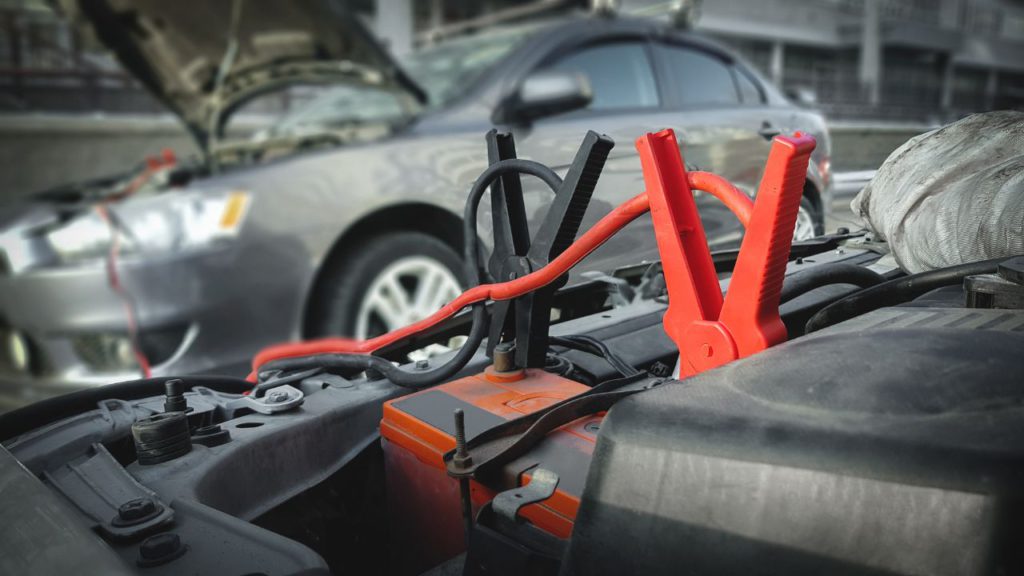Going to work, school, or grocery, but your car won’t start? Don’t order a brand-new car battery or call roadside assistance just yet. Try these methods how to start a car with a dead battery first.
Table of Contents
How To Start a Dead Car Battery?
The type of transmission your vehicle has is significant in how you can start a car with a dead battery. But in general, you will need the following:
- Jumper cables
- A jump box or a portable jump-starter
- A second car with a working battery
- Friends (to help with pushing)
Manual Transmission
A vehicle with a manual transmission has a clutch pedal and a gear stick to engage the gearbox. If the ignition fails to start, a drained battery is most likely the problem.
Below are the different methods on how to start a car with a dead battery:
Method 1: Push Starting
Push starting or clutch starting is the most common way to start a dead battery of cars with manual transmissions. But how does it work?
Simply put, the method involves pushing the car to force the engine to start. The process involves engaging the car’s clutch and rolling the vehicle to turn over and start the engine.
Expert Tip: Only vehicles with manual transmissions and internal combustion engines can use the push-starting method to start the engine.
Push Start A Car With Help

The process of push-starting a car involves the following steps:
Safety precaution: Before trying this method, ensure that your vehicle is not parked on an inclined road. There is a high tendency that the car will reserve back. Plus, it’s harder to push. A slight incline is okay.
- Sit in the driver’s seat and have a friend push the car. If you have a truck or an SUV, you will need more than one friend to help move the vehicle.
- Turn off all car accessories, including lamps, radios, and wipers.
- Turn on the ignition key. The car may roll if you engage the clutch without turning on the ignition.
- Press the clutch pedal.
- Shift the transmission to the first gear. You can also shift to the second gear.
- Release the hand brake and the brake pedal.
- Ask the people assisting you in pushing the car and getting it rolling as fast as possible.
- Release the clutch pedal while partially depressing the gas pedal to approximately five mph.
- If the engine fails to start, repeat the whole process.
Push Start Without Help
If you are push-starting the car without help, you can follow the following steps:
- Make sure the car is on a flat surface. If the vehicle is on an inclined road, never attempt this method.
- Turn on the ignition key. Shift the transmission gear to neutral and disengage the parking brake. At this point, the vehicle will start rolling freely.
- Leave the door to the driver’s side open.
- Push the car from the windshield pillar. Support yourself using the front post of the driver’s door.
- In a swift motion, get into the car and onto the driver’s seat.
- Press the clutch pedal, shift the car’s transmission to the second gear and release the clutch pedal.
- To keep the engine running, press the clutch pedal immediately or the gas pedal to drive the car.
- If the car’s engine does not start, repeat steps two to seven.
Method 2: Use A Jump Start Box
With a jump start box, you don’t need to flag down a passing car to give your vehicle a jump start.

A jump start box is a portable battery pack with booster cables that revives a car’s battery without needing another vehicle to connect. You don’t need a second person to push your car. Plus, you can revive a dead car battery anytime and anywhere!
Expert Tip: Using a jump start box is relatively safe. It has reverse-polarity and anti-spark protection, meaning it doesn’t deliver power unless connected correctly.
So, how do you start a car with a dead battery using a jump start box? Here is how:
All you need to do is:
- Find the battery terminals. The posts are usually covered. For instance, the positive post is protected by a red cover, whereas the negative terminal is covered by a black plastic flap. Simply flip the cover to access the posts.
- Connect the positive cable (red cables) to your battery’s positive post.
- Take the negative cable (black cables) and attach it to the engine block or another non-conductive grounded surface.
- Turn on the portable car jumper.
- After five minutes, turn on the ignition.
- Keep it connected to your vehicle for at least one minute.
- Turn off the portable car jumper.
- Disconnect the positive and negative cables.
Methods 3: Use Jumper Cables

Jumper cables are insulated wires with insulated alligator clips at each end. The cables are used in pairs to connect a disabled battery or equipment to an auxiliary source, which may be another battery or equipment of the same voltage system.
It is advisable to use jumper cables that are 4-10 gauge and approximately 12 ft long.
Expert Tip: When buying jumper cables from auto parts stores or online, always opt for longer cables with heavier and thicker clamps.
Using jumper cables to start a car requires you to be extra cautious. This is because incorrectly connecting the wires can create dangerous sparks.

The process of how to use jumper cables to start a dead vehicle includes the following:
- Park the car with a good battery next to the car with the dead battery
- Open the bonnet of both cars to access the batteries. If the batteries have plastic hood covers, start by removing the hoods to expose the battery posts.
- Locate the positive and negative posts on the batteries. In mostƒ instances, the positive posts are red and indicated with the plus sign. The negative post may be black or bear the minus sign to indicate polarity.
- Get the jumper cables and firmly connect the red clamp to the positive terminals of the dead battery. Attach the other end to the positive terminal of the working battery.
- Firmly connect one end of the black clamps to the good battery’s negative terminal. However, instead of connecting the other end of the jumper cables to the negative terminal of the dead car battery, clamp it to the metal surface on the dead car’s engine.
- Start the car’s engine with a good battery and let it sit idle for a few minutes.
- Start the car’s engine with the dead battery and let it sit idle for a few minutes.
- If your car starts without complications, you can disconnect the jumper cables.
Expert Tip: You can keep the car with the previously dead battery running for a while to recharge the battery further.
Automatic Transmission
If your car doesn’t have a clutch and you only see R (reverse), N (neutral), D (drive), and P (park) in the gearbox, your vehicle has an automatic transmission.
Unlike vehicles with a manual transmission, you cannot push start an AT car. Luckily, you can use jump start boxes and jumper cables. The steps are exactly the same in manual transmissions.
Dead Car Battery FAQ
Will a Dead Car Battery Recharge Itself?
Unfortunately, a dead car battery will not recharge itself. Instead, the alternator will recharge the dead car battery. Ideally, the battery’s main role is to help start the car and power electronics if the engine is off. Hence, the batteries do not produce energy but store the energy.
However, with the frequent use of the battery, it may discharge, leaving room for the alternator to recharge and compensate for the lost power. The alternator then converts the engine’s mechanical energy to electrical energy that recharges the dead battery.
How Do I Know When My Car Battery Needs Replacing?
The most common signs to know when to replace your car battery include the following:
- The “Check Engine” light turns on
- Your engine takes a long time to start
- Nothing happens when you turn the key
- The car experiences electrical issues, and the lights within the car seem dim
- The windows roll slowly
- Slow windshield wipers
- The battery connectors are corroded
- Foul smell resulting from battery leak
- Physical damage to the battery, i.e., swelling or cracking
- Old age
How Long Should I Let My Car Run After a Jump?
You should let your car run for at least 15-30 minutes after jumping it. You should also drive it around instead of letting it idle. Remember that the amount of charge gained by the battery will depend on the battery’s size and condition.
In A Nutshell…
You can always revive a dead car battery, provided you have the tools and know the steps. If you still cannot start your vehicle, there is always an option to seek roadside assistance as your last resort.
